Papers by Riansares Muñoz-Olivas
Journal of Analytical Atomic Spectrometry, 2011
ABSTRACT This study examined the effects of arsenic exposure and the biotransformation capacity o... more ABSTRACT This study examined the effects of arsenic exposure and the biotransformation capacity of developing Iberian green frogs (Rana perezi) with the main aim of finding valid biomarkers to monitor pollution and toxicological problems. Total arsenic concentration and arsenic species distribution were determined using liquid chromatography coupled with inductively coupled plasma-mass spectrometry (LC-ICP-MS). The level of accumulation of arsenic and its species distribution differed depending on the metamorphosis stage and level of exposure. Tetramethylarsonium cation was the major compound detected and continuously increased in concentration during frog development. Results suggest that rather low As accumulation is obtained and that Rana perezi metabolised arsenic during embryonic and larval development.

En este proyecto de innovacion se persigue enriquecer la formacion de los estudiantes de las facu... more En este proyecto de innovacion se persigue enriquecer la formacion de los estudiantes de las facultades de ciencias (F. CC.FF. y F. CC.QQ.) mediante una propuesta teorico-practica basada en la metodologia Aprendizaje-Servicio (ApS) y encaminada a facilitar la inclusion de personas con diversidad funcional, especialmente diversidad cognitiva. El proyecto parte del diseno de talleres cientificos por los estudiantes universitarios para ser realizados por parejas de estudiantes preuniversitarios de manera colaborativa e inclusiva, ya que un miembro de la pareja procedera de un centro de educacion especial y el otro de un centro educativo ordinario (colegio o Instituto de educacion secundaria) de la Comunidad de Madrid. Tanto el diseno de los experimentos como su eventual puesta en practica seran supervisados por los integrantes del proyecto: estudiantes de doctorado, personal de administracion y servicios (PAS) y personal docente e investigador (PDI), asi como por los colaboradores exte...

Nanotoxicology, 2014
The production of titanium dioxide nanoparticles (TiO 2 NPs) for commercial applications has grea... more The production of titanium dioxide nanoparticles (TiO 2 NPs) for commercial applications has greatly increased over the last years and consequently the potential risk for human health. There is a growing awareness of the need to understand the behavior and influence these nanoparticles exert on the environment. Bioaccumulation serves as a good integrator to assess chemical exposure in aquatic systems and is dependent on factors, such as the exposure routes, diet and the aqueous medium. We analyzed the experimental bioaccumulation capability of ionic titanium and TiO 2 NPs by zebrafish (Danio rerio) eleutheroembryos through bioconcentration factors (BCFs), after 48 or 72 h of exposure. The stability of both chemical forms in an aquatic medium was fully characterized for further bioaccumulation studies. Several stabilizing agents (humic acids, soluble starch, polyethylene glycol, Na 4 P 2 O 7 and Na 2 HPO 4 ) for anatase and rutile, the two allotrophs of TiO 2 NPs, were evaluated to check the evolution of the aggregation process. Around 60% of TiO 2 NPs remained disaggregated under simulated environmental conditions with the addition of 50 mg L À1 of humic acids. However, the presence of eleutheroembryos in the exposure medium increased TiO 2 NPs aggregation in the experimental tests. The BCFs values obtained in all cases were 5100, which classifies ionic titanium and TiO 2 NPs as non-bioaccumulative substances, under the REACH regulations.
Water Research, 2011
Inorganic arsenic Tributyltin Ultrasound-assisted extraction a b s t r a c t

The Analyst, 2002
Two procedures have been investigated for the quantification of the different forms of mercury in... more Two procedures have been investigated for the quantification of the different forms of mercury in food. A two-stage procedure has been developed to determine firstly total inorganic and organometallic species, and then the full separation of all organomercury species. The procedure involves solubilisation of the samples using alkaline extractions or enzymolysis, followed by the extraction of organic mercury in an organic solvent, preferably a mixture of dichloromethane and hexane (3:2). For the total organic mercury determination, the organic extract is analysed for "total" mercury after nitric acid/peroxide digestion, evaporation of the solvent and detection by cold vapour-atomic fluorescence spectrometry. Full organomercury speciation requires a clean-up step before analysis of the final extract in dichloromethane by gas chromatography coupled to a pyrolyser and an atomic fluorescence detector (GC-pyro-AFS). A detection limit of 6 ng l-1, and reproducibility of 2% was achieved for the CV-AFS method; GC-pyro-AFS yielded 200 ng l-1 and 5% for detection limit and coefficient of variation, respectively. Both procedures were validated with the use of various certified reference materials over a wide range of mercury concentrations, and by spiking experiments. The validated methods were tested successfully on a wide range of commercially available food samples.
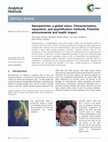
Analytical Methods, 2014
Nanotechnology is a multidisciplinary science that includes scientific and technological activiti... more Nanotechnology is a multidisciplinary science that includes scientific and technological activities at molecular and atomic scales (1-100 nm). Scientific principles and new properties can be understood and controlled when working at this scale. Nanotechnology is advancing rapidly due to the great progress achieved in various fields including electronics, mechanics, medicine, cosmetics, food, etc. This increased use of nano-sized materials leads to the release of a substantial amount of nanoparticles into the environment. To date there is a lack of standardized procedures to assess their safety and impact on the environment. Specific toxicological studies as well as characterization and quantification of nanoparticles are required to establish regulations to control field application of nanoscale materials. A classification of nanoparticles and the techniques employed in their characterization, separation, and quantification are summarized and described in this review. A global perspective on nanoparticle exposure and environmental effect is also discussed.
Sample preparation for pharmaceutical dosage forms can be a time-consuming and labor-intensive ta... more Sample preparation for pharmaceutical dosage forms can be a time-consuming and labor-intensive task. One option to reduce or eliminate this work is to use an analysis method that requires no or minimal sample preparation. This chapter discusses uses of vibrational spectroscopy (e.g., infrared, Raman) and mass spectrometry techniques to analyze dosage forms with no or minimal sample preparation to obtain identification, polymorph, water content, potency, and purity information. A high-level description of these techniques will be presented along with example applications.

RESUMEN. Se realizaron investigaciones acerca de la remediación de aguas residuales para prevenir... more RESUMEN. Se realizaron investigaciones acerca de la remediación de aguas residuales para prevenir daños, tanto de las reservas de aguas subterráneas como superficiales. Con este propósito, las tierras de diatomeas, un barato, disponible y no contaminante material, fue ensayado para la retención de contaminantes per-sistentes, tales como los metales pesados (cadmio) y pesticidas (antracita y cloropirifos). Esto ha sido utilizado en la prevención de la contaminación de aguas subterráneas debido a su gran movilidad reportada y a la irrigación y limpieza de suelos destinados a la agricultura. Variables tales como profundidad, espesor, etc. de los suelos quedaron cuidadosamente establecidos para simular una explotación casi real de suelos potencialmente contaminados. Los resultados preliminares presenta-dos aquí muestran porcentajes de retención de cadmio mayores del 75 % y del 50 % para la antracita. Estos enfatizan el potencial uso como limpiador y remediador de las tierras de diatomea...
Handbook of Elemental Speciation: Techniques and Methodology, 2003

Biological Trace Element Research, 2014
Organotin compounds are highly versatile group of organometallic chemicals used in industrial and... more Organotin compounds are highly versatile group of organometallic chemicals used in industrial and agricultural applications. Their endocrine-disrupting effects are well known and their extensive uses as biocide materials, e.g., in antifouling paints, for many years have led to serious environmental problems. So far, attention has mainly been given to tributyltin pollution in water, sediments, and marine organisms because of its highly toxic effects and high accumulation levels at very low concentrations. In this study, we will focus on the conversion of tributyltin after it is absorbed by zebrafish eleutheroembryos, presented here as an alternative model to adult fish for describing bioconcentration. A simplified analytical extraction procedure based on the use of an assisted ultrasonic probe and derivatization by ethylation, followed by gas chromatography with a flame photometric detector (GC-FPD) is proposed. This classical methodology for organotin determination has been validated by inductively coupled plasma mass spectrometry (ICP-MS) and Zeeman graphite furnace atomic absorption spectrometry (ZGF-AAS) in terms of total tin content. The speciation analysis results show that zebrafish eleutheroembryos absorb high amounts of tributyltin and convert it into monobutyltin and likely in inorganic tin.

The Analyst, 2006
The covalent imprinting approach has for the first time been successfully applied for the synthes... more The covalent imprinting approach has for the first time been successfully applied for the synthesis of an imprinted polymer able to recognize organotin species. The synthesis has been accomplished by co-polymerization of the complex Bu(2)SnO-m-vinylbenzoin as the imprinting template plus co-monomer sodium methacrylate, and ethylene glycol dimethacrylate as cross-linker. The imprinting effect has been evidenced within the narrow pH range 2.5< pH< 3.5. At lower pH values, the imprinting effect is prevented by the exclusive existence of non-specific interactions, whereas pH>3.5 provokes a strong rebind of the template in both imprinted and non-imprinted polymers. This pH dependency can be explained as a selective chemical modification which reduces bind diversity following a model based on enolization by protonation of the specific cavities. Characterization of the adsorption isotherms showed good agreement with the Langmuir-Freundlich (LF) model, presenting quite homogeneous binding sites for a bulk material and high capacity in the imprinting pH range. In addition, the affinity spectrum (AS) method has been represented showing the typical profiles of LF isotherm for both sub-saturation and saturation levels, being in general agreement with the encountered values for fitting coefficients. The covalent molecular imprinted polymer has been successfully evaluated in a SPE process for further OTC determination in the certified mussel tissue (CRM 477).
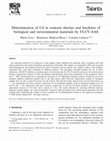
Talanta, 2000
An analytical method for Cd analysis in solid samples which combines the ultrasonic slurry format... more An analytical method for Cd analysis in solid samples which combines the ultrasonic slurry formation with cold vapour generation and atomic absorption spectrometry is described. The samples are suspended in HCl and sonicated until homogeneous and reduced particle size slurry formation. Several aspects were studied: acidity of the medium, sonication time, and slurry formation in different matrices. The procedure described permits the use of direct calibration, with KCN addition as masking agent of interfering ions (Cu, Pb, Ni and Zn) present in the environmental matrices. Supernatant analysis of these last samples experimentally shown that preparation of the suspension with 6 mol l − 1 HCl concentration led to quantitative extraction of Cd. Biological materials analysis needed the use of the standard addition calibration method due to the high matrix effect observed. Supernatant analysis in biological samples does not give a total Cd recovery for all of them. The detection limits observed for Cd were 0.05 and 0.2 mg l − 1 for supernatant and slurry analysis respectively in environmental samples, while in biological samples were 0.2 and 0.6 mg l − 1 for supernatant and slurry analysis, respectively. In all case the better precision was obtained for supernatant analysis (3-6%) than slurry analysis (6 -12%). The results obtained by analysing different reference materials (sewage sludge, city waste incineration, Antarctic krill and human hair) showed good agreement with the certified value confirming the validity of such a method for Cd determination instead to wet digestion procedures.

Spectrochimica Acta Part B: Atomic Spectroscopy, 2004
A new adsorbent based on the imprinting technique with high retention capacity and pre-concentrat... more A new adsorbent based on the imprinting technique with high retention capacity and pre-concentration factor has been synthesized and tested for retention of inorganic and organotin compounds wtributyltinchloride (TBT), dibutyltindichloride (DBT), monobutylytintrichloride (MBT) and triphenyltinchoride (TPhT)x. The polymerization has been carried out in the presence of TBT, the target organotin compound of this work. These compounds can be quantitatively retained on this adsorbent over a wide pH range and after elution these compounds are determined by graphite furnace atomic absorption spectrometry (GFAAS). Only organotin compounds are eluted from the adsorbent with 0.1 M hydrochloric acid (HCl) in methanol (MeOH) solution whereas inorganic tin is eluted later on with a suitable complexing agent such as citric acid. Linearity is obtained in the concentration range 0.1-4 ng (5-200 mg l ) for each organotin compound with a correlation coefficient not less than 0.994 and relative y1 standard deviation -5% even for complex samples such as sediments and seawater samples. The detection limit has been found to be 30 ng l . Various parameters related to determination, pre-concentration and GFAAS conditions have been optimized. The y1 screening method proposed has been applied to the determination of organotin in natural sediments and seawater samples. The recovery is between 82 and 90% for TBT, DBT and TPhT and 50-55% for MBT in the case of sediment samples, while it is 97-103% for all the organotin compounds in seawater samples. The method has been conveniently validated using a standard sediment reference material. ᮊ

PLoS ONE, 2012
Arsenic toxicity has been studied for a long time due to its effects in humans. Although epidemio... more Arsenic toxicity has been studied for a long time due to its effects in humans. Although epidemiological studies have demonstrated multiple effects in human physiology, there are many open questions about the cellular targets and the mechanisms of response to arsenic. Using the fission yeast Schizosaccharomyces pombe as model system, we have been able to demonstrate a strong activation of the MAPK Spc1/Sty1 in response to arsenate. This activation is dependent on Wis1 activation and Pyp2 phosphatase inactivation. Using arsenic speciation analysis we have also demonstrated the previously unknown capacity of S. pombe cells to reduce As (V) to As (III). Genetic analysis of several fission yeast mutants point towards the cell cycle phosphatase Cdc25 as a possible candidate to carry out this arsenate reductase activity. We propose that arsenate reduction and intracellular accumulation of arsenite are the key mechanisms of arsenate tolerance in fission yeast. Citation: Salgado A, Ló pez-Serrano Oliver A, Matia-González AM, Sotelo J, Zarco-Fernández S, et al. (2012) Response to Arsenate Treatment in Schizosaccharomyces pombe and the Role of Its Arsenate Reductase Activity. PLoS ONE 7(8): e43208.
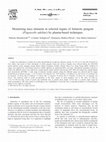
Microchemical Journal, 2006
A study was undertaken to evaluate the content and distribution of eight key elements, namely, As... more A study was undertaken to evaluate the content and distribution of eight key elements, namely, As, Cd, Co, Cu, Hg, Mn, Pb and Se in liver, kidney and muscle of chick individuals of Adélie penguin (Pygoscelis adeliae). Samples were collected during the 2002/2003 austral summer season campaign around Jubany Station (Argentine scientific station), Potter Cove, King George Island. Solutions of organs were prepared by acid-assisted microwave (MW) digestion by employing HNO 3 and H 2 0 2 . Instrumental techniques selected to analyze the different tissues were inductively coupled plasma optical emission spectroscopy (ICP OES) and inductively coupled plasma mass spectrometry (ICP-MS). A wide range of elements retention capacity among the different organs was observed and the ranges ascertained are as follows (in Ag g À 1 ): As, 0.5 (liver) -0.8 (muscle); Cd, < 0.07 (muscle) -3.4 (kidney); Co, 0.07 (liver) -0.7 (muscle); Cu, 0.6 (muscle) -18 (liver); Hg, 0.2 (kidney) -2.7 (liver); Mn, 1.5 (muscle) -10 (liver); Pb, 0.1 (muscle) -2.0 (liver); Se, 3.0 (muscle) -8.4 (liver). The observed trend in metal accumulation in the three organs of chick penguins was in the order Cu > Mn > Se > > As > Co > Pb > > Cd > Hg. Levels of metals and metalloids were, in general terms, higher in liver that is a specific target organ for metal accumulation. This study aimed at contributing to the establishment of base-line data on potential pollutants of ecotoxicological interest in the Antarctic ecosystem. D

Journal of Environmental Science and Health, Part A, 2007
In the present study, pressurised liquid extraction and ultrasound probe sonication, for the latt... more In the present study, pressurised liquid extraction and ultrasound probe sonication, for the latter in combination with a mixed enzymatic treatment in case of rice and straw samples, were applied as sample preparation prior to arsenic speciation analysis by high pressure liquid chromatography coupled to inductively coupled plasma mass spectrometric detection (HPLC-ICP-MS). A significant number of samples as different as rice, straw, soil, nail and hair, all coming from the heavily arsenic-contaminated Middle and Lower Ganga plain area, could be investigated with validated methods, supported by high speed extraction methods. For rice and paddy samples, inorganic arsenic counted up to 70-98% of the total arsenic content, being the major species As (III). The levels of arsenic obtained from straw and soil samples are significantly higher than the background levels, being the may or species As (V), thus increasing human exposure to arsenic via the soil-plant-animal-human pathway. Concentrations found in hair and nails were significantly higher than their background levels: 39-and 20-fold for hair and nails, respectively. These samples contained mainly inorganic arsenic in its tri-and pentavalent forms. Results indicate that, under the local frame conditions, arsenic mainly enters into the food chain via its more problematic inorganic forms. Arsenic speciation analysis proves to be a powerful tool for a complete analytical assessment in epidemiological studies covering the endemic areas. 5 10
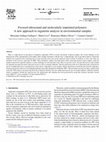
Journal of Chromatography A, 2006
There is a high interest in speciation of organotin compounds (OTCs) in biota and marine sediment... more There is a high interest in speciation of organotin compounds (OTCs) in biota and marine sediment samples, due to their influence in the transmission of the contamination in the trophic chain. Sample treatment is still the most "compromising" step of speciation analysis. Extraction methods are in general time-consuming due to long extraction times and several analytical steps involved. In addition, in most cases there are problems of low recovery, especially for MBT. These drawbacks, added to the high matrix effects generally present in biota samples, make the sample treatment for organotin analysis a serious challenge for environmental issues. Here we present a novel, fast and efficient two steps method for organotin speciation in mussel and oyster tissue as well as in marine sediments. The first step based on the use of ultrasonic probe extraction for species leaching allowed us to quantitatively extract these compounds in a few minutes. Matrix interferences drastically decreased by applying a clean-up step based on the use of an imprinted polymer especially designed for tributyltin (TBT). This procedure increased accuracy and precision of the GC-FPD analysis and improving the limit of detection, Besides, this new method prevents the use of standard addition calibration method, which is mandatory without the clean-up step. The optimization and validation has been performed by using three reference materials: mussel tissue CRM-477, oyster candidate T-38 and sediment PACS-2.

Journal of Chromatography A, 2005
Arsenic speciation analysis suffers in general from high sample handling time required by sample ... more Arsenic speciation analysis suffers in general from high sample handling time required by sample preparation. In a previous work, ultrasonic probe has been proved to reduce sample treatment time for arsenic extraction in rice to only a few minutes. Base upon the obtained results, here several extraction media for chicken, fish and soil samples (SEAS G6RD-CT2001-00473) have been studied and evaluated employing the same technique. Chicken sample needed an enzymatic treatment in order to liberate the species linked to the protein matrix. Extraction of the major species in fish, AsB, was quantitatively achieved in water in 1 min. Also 1 min was enough to leach about 85% of species present in soils and sediments, mainly the inorganic ones, using H(3)PO(4). In all cases, no inter-conversion among As species was observed. The five species found in those samples were separated using an improved HPLC-ICP-MS method in only 11 min, with detection limits at the ng l(-1) level. The proposed methods were validated by analysing several Certified Reference Materials: SRM 1,568 a rice flour, CRM-627 tuna fish tissue, SOIL-7 soil and MURST-ISS-A1 Antarctic sediment.

Journal of Chromatography A, 2010
Molecular imprinting technology has been employed for the first time to prepare a specifically af... more Molecular imprinting technology has been employed for the first time to prepare a specifically affinity chromatographic stationary phase for speciation purposes. Tributyltin has been chosen as the template molecule and the non-covalent approach has been applied. Three different polymerization methods have been evaluated: (i) a composite material, (ii) a polymer prepared via-Iniferter grafting; (iii) an emulsion polymer. Columns packed with different polymers have been evaluated by liquid chromatography (LC) coupled to inductively coupled plasma mass spectrometry (ICP-MS). The chromatographic conditions as well as the analytical characteristics of the developed method are discussed in this paper. Our findings have shown formation of specific cavities in the grafted Iniferter as well as in the emulsion polymers with the latter achieving resolution of four organotin compounds. Detection limits are similar to those obtained with commercial, but not specific, stationary phases (6 pg for monobutyltin, MBT; 10 pg for both tributyltin, TBT, and triphenyltin, TPhT; and 20 pg for dibutyltin, DBT). The main advantage of this proposed stationary phase is that good recovery is obtained for all species, including MBT. Baseline resolution for TBT and TPhT has also been obtained. The high selectivity of this column prevents matrix interferences. The method has been validated by analyzing two biota reference materials (ERM-CE477 mussel tissue and T-38 oyster tissue).
Journal of Analytical Atomic Spectrometry, 2011
This study examined the effects of arsenic exposure and the biotransformation capacity of develop... more This study examined the effects of arsenic exposure and the biotransformation capacity of developing Iberian green frogs (Rana perezi) with the main aim of finding valid biomarkers to monitor pollution and toxicological problems. Total arsenic concentration and arsenic species distribution were determined using liquid chromatography coupled with inductively coupled plasma-mass spectrometry (LC-ICP-MS). The level of accumulation of arsenic and its species distribution differed depending on the metamorphosis stage and level of exposure. Tetramethylarsonium cation was the major compound detected and continuously increased in concentration during frog development. Results suggest that rather low As accumulation is obtained and that Rana perezi metabolised arsenic during embryonic and larval development.




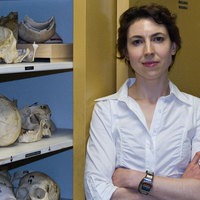


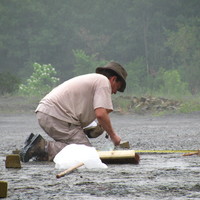


Uploads
Papers by Riansares Muñoz-Olivas